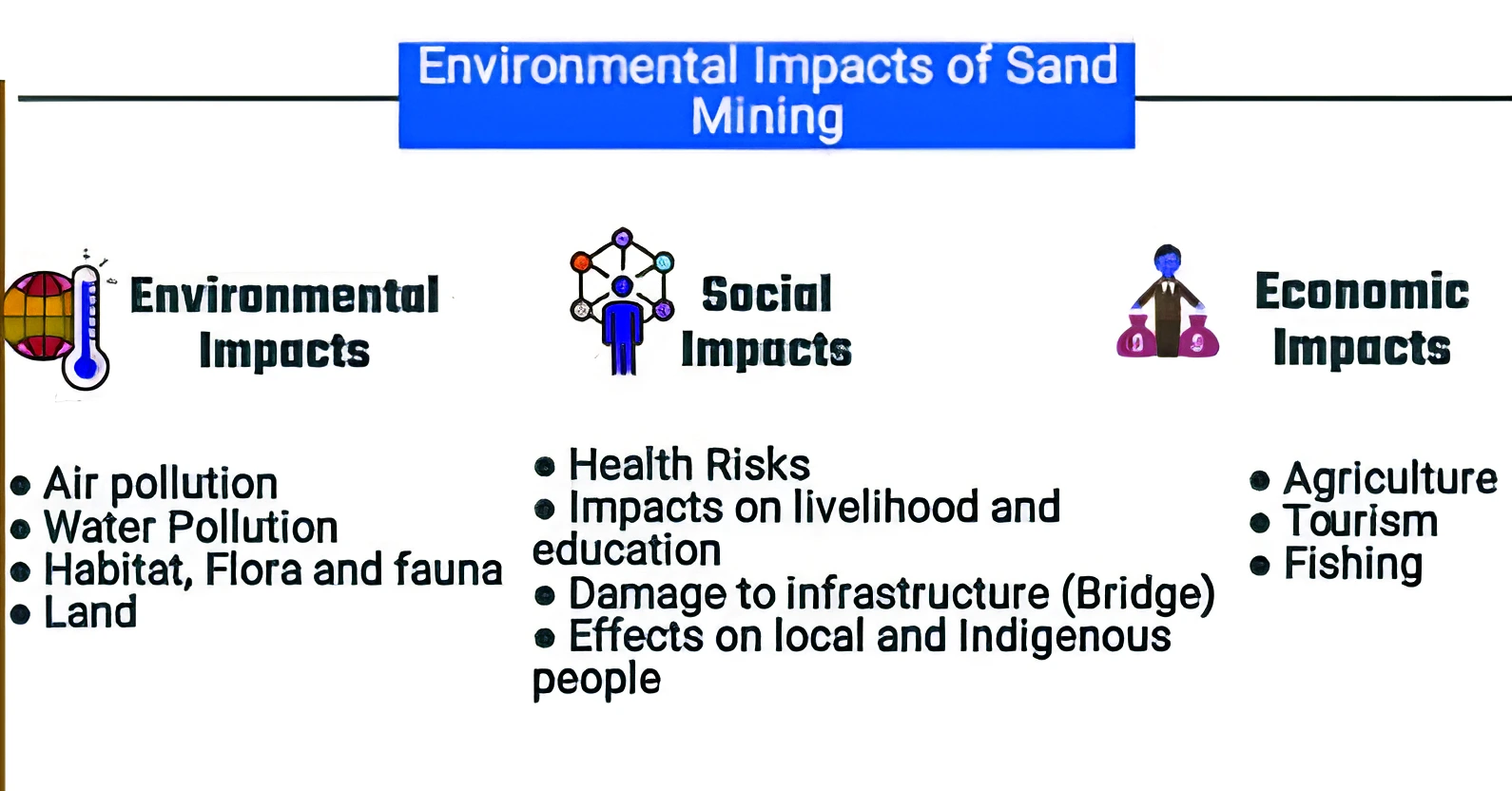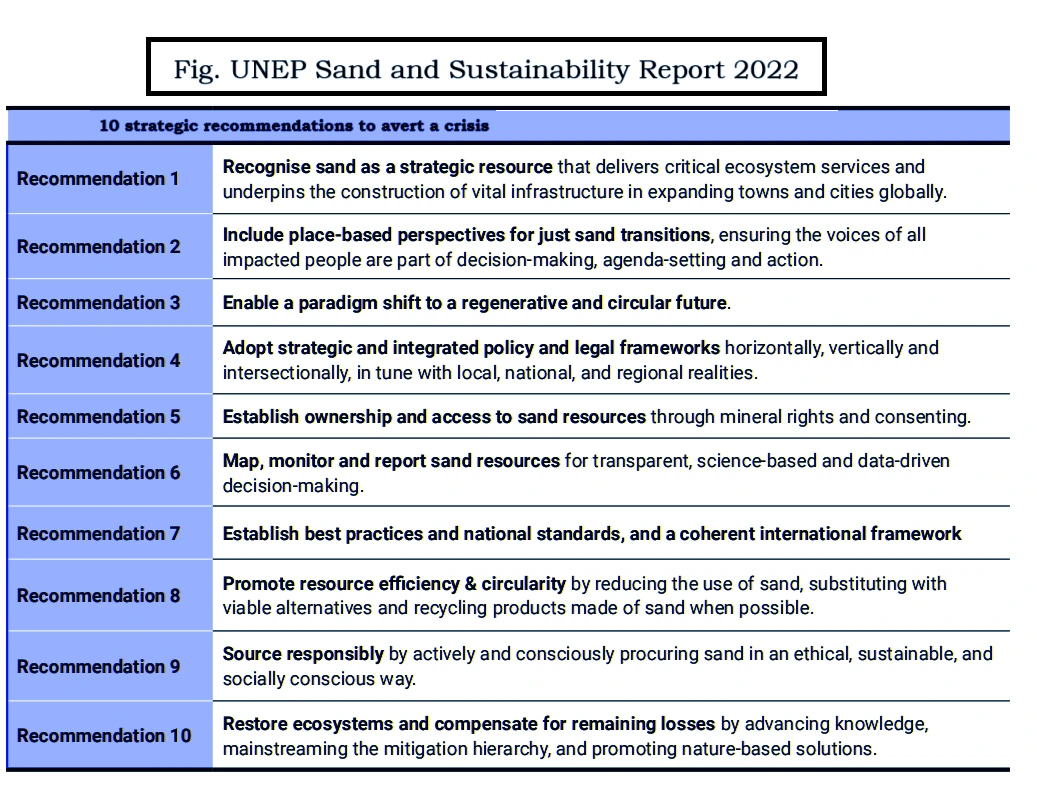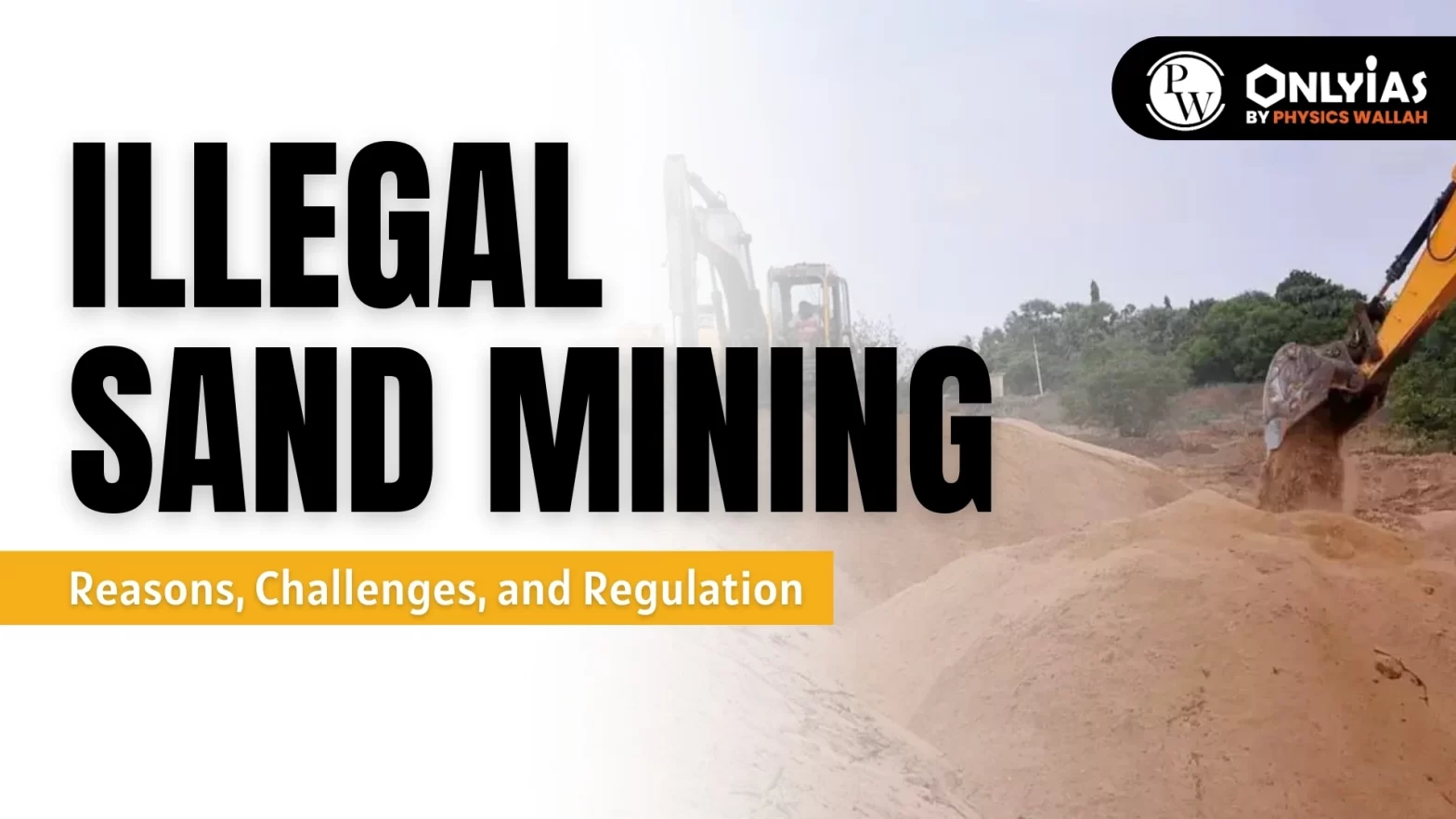Context: This article is based on the news “Illegal sand mining: 20 arrested, 40 big boats seized in Bihar police operation on Sone river” which was published in the Down To Earth. Recently, the Bihar police arrested 20 sand smugglers and seized 40 sand-laden boats in a major crackdown against illegal sand mining in the state.
| Relevancy for Prelims: Illegal Sand Mining, Sone River, Environment (Protection) Act, 1986, the Forest (Conservation) Act, 1928, the Water (Prevention and Control of Pollution) Act, 197429, and the Air (Prevention and Control of Pollution) Act, 198130 and the Wild Life Protection Act, 1972, and Mines And Minerals (Development And Regulation) Act, 1957.
Relevancy for Mains: Illegal Sand Mining in India: Reasons, Challenges, Regulation, Government Initiatives, and Way Forward. |
Action taken Against illegal sand mining in Son river
- Sand Mafias: Illegal sand mining is carried out by powerful mafias in several districts of Bihar during the monsoon.
- Police Action: The police action occurred on the Sone River in Patna district.
- Counter-Attack: Criminal syndicates have been attacking & killing police officials who have cracked down upon them.
- For example, an additional SHO was crushed to death by a tractor-driver carrying illegal sand in Jamui district, Bihar
About Sand and Sand Mining
- Sand: It is considered to be an essential material as it is used for making concrete, building sites, filling roads, making bricks, making glass, sandpapers, etc.
- Importance of Sand: Sand plays a strategic role in delivering ecosystem services, maintaining biodiversity, supporting economic development, and providing livelihoods within communities.
- Sand Mining: According to UNEP, sand mining (extraction) is the removal of primary natural sand and sand resources from the natural environment to extract valuable minerals for subsequent processing.
About Illegal Sand Mining
According to the Supreme Court in the judgment given in Common Cause v. Union of India, illegal mining is the operations undertaken by any person in any area without holding a mining lease and any other mining operation conducted in violation of the terms of the mining scheme, the mining plan, and the mining lease as well as the statutes such as the Environment (Protection) Act, 1986, the Forest (Conservation) Act, 1928, the Water (Prevention and Control of Pollution) Act, 197429, and the Air (Prevention and Control of Pollution) Act, 198130 and the Wild Life Protection Act, 1972.
- Regulation of Mining: Mines And Minerals (Development And Regulation) Act, 1957 (MMDR Act) provide for the development and regulation of mines and minerals under the control of the Union.
- Sand: It is a minor mineral under Section 3(e) of the MMDR Act and control of illegal mining comes under the legislative and administrative purview of the State Governments.
- Section 15 of the MMDR Act: It empowers the State Governments to make rules for regulating the grant of quarry leases, mining leases or other mineral concessions in respect of minor minerals and for purposes connected therewith.
- Section 23C of the MMDR Act: It empowers the State Governments to make rules for preventing illegal mining, transportation and storage of minerals and for the purposes connected therewith.
Must Read: Mines and Minerals (Development and Regulation) Amendment Bill, 2023
Reasons for Illegal Mining of Sand
- High Demand and Limited Supply: The need for sand has led to the proliferation of sand mining, with the principal driver of this crisis being rapid urbanisation. The legal supply of sand often falls short of meeting this demand, leading to illegal mining activities.
- Unholy Nexus: Corruption within the regulatory bodies and law enforcement agencies can facilitate illegal sand mining. Nexus between illegal miners and officials may lead to overlooking or neglecting illegal activities.
- The Goa bench of the Bombay High Court said that neither the Director General of Police (DGP) nor the Chief Secretary were “seriously interested” in preventing illegal sand mining in the state.
- Poverty and Unemployment: In certain regions, poverty and lack of alternative livelihood opportunities drive people to engage in illegal sand mining as a means of income.
- For example, workers dig the banks of the Son to retrieve the “pila sona” (yellow gold) in Bihar for about 400 rupees a day to feed their families.
Challenges Associated with Illegal Sand Mining
- Violence Associated with Sand Mafias: There are organised sand mafias in India that mine the valuable resources from rivers and coasts. The mafia can eliminate public servants, workers, activists and journalists who have raised their voices against them.
- According to South Asia Network on Dams, Rivers and People (SANDRP), at least 261 people have lost their lives, and about 351 persons have faced injuries due to riverbed mining-related violence and accidents in India between April 2022 and February 2023.
- Impacts on Infrastructure: Excessive sand mining can weaken infrastructure such as bridges and embankments, posing risks to public safety.
- For example, the excessive extraction of sand led to the collapse of Mullarapatna Bridge just 30 years after it was built on the Phalguni River blame in Karnataka, according to the Indian Bureau of Mines.
 Environmental Challenges: Illegal sand mining often leads to severe environmental degradation, which can result in the erosion of riverbanks, disruption of ecosystems, and loss of biodiversity.
Environmental Challenges: Illegal sand mining often leads to severe environmental degradation, which can result in the erosion of riverbanks, disruption of ecosystems, and loss of biodiversity. -
- Slow Replenishment: Every year, billions of tons of sand are extracted from lakes, riverbeds, coastlines, and deltas. However, the process by which sand can be naturally replenished is prolonged, disrupting ecosystems and causing biodiversity loss.
- Water Quality Issues: Sedimentation caused by excessive mining can lead to increased turbidity in water, affecting aquatic life and making water sources unsuitable for consumption.
- Threats to Aquatic Life: Illegal sand mining has led to the devastation of rivers like Narmada, Chambal, and Betwa in Madhya Pradesh, Bharathappuzha River in Kerala
- National Chambal Sanctuary, Rajasthan, Madhya Pradesh and Uttar Pradesh has faced a wide range of illegal sand mining. The sanctuary is listed as an ‘Important Bird and Biodiversity Area’ and is known for its population of critically endangered gharials.
- Loss of Revenue for the Government:.Governments lose potential revenue when sand is extracted illegally, as these activities often go unregulated and untaxed.
- For instance, illegal sand mining costs the state exchequer an estimated annual loss of Rs 7,000 crore in Bihar.
Government Initiatives to Curb Illegal Sand Mining
- Sustainable Sand Mining Management Guidelines (SSMMG), 2016 : The Ministry of Environment, Forest & Climate Change has issued these guidelines which addresses the issues relating to regulation of sand mining.
- The guidelines highlights the identification of the sand mining sources, replenishment of the River Bed Material (Sand, Boulder, Gravel, Cobble, etc.), preparation of Districts Survey Report, and Standard Environmental Conditions suitable for sand mining projects.
- Enforcement and Monitoring Guidelines for Sand Mining 2020: This document is supplemental to the existing SSMMG 2016, introduced with the objective of
- Identification and quantification of mineral resource and its optimal utilization.
- To regulate the sand & gravel mining in the country from its identification to its final end-use by the consumers and the general public.
- Use of IT-enabled services & latest technologies for surveillance of the sand mining at each step etc.
- Environment Impact Assessment (EIA) Notification 2006: It prescribes mandatory environmental impact clearance for small-scale sand mines.
- Sand Mining Framework: The Ministry of Mines has prepared this framework incorporating best practices amongst States with the objectives of sustainability, availability, affordability and transparency in sand mining.
International Framework Associated with Illegal Sand Mining
- Convention on Biological Diversity (CBD): Article 7 obligates the member States to identify, monitor and assess the impact of sand mining and other activities on the environment.
- UN Convention on the Law of the Sea (UNCLOS): Articles 208 and 214 of the Convention impose a duty on the States to create and enforce laws and regulations that help in preventing, reducing, and controlling pollution in the marine environment that has been caused by activities like sand mining.
|
Way Forward to prevent Illegal Sand Mining
- Using Alternatives of Sand: According to the UNEP, important ways to reduce the amount of sand extracted include avoiding unnecessary natural sand consumption in construction and using alternatives.
- Promotion of manufactured sand, artificial sand, fly ash, etc. as alternative technologies in construction materials can substantially reduce demand of sand.
- For example, in Singapore, copper slag has been substituted for sand in the production of concrete.
- Some countries, including China and the United States, have begun producing “crushed rock” as an alternative.

- Strengthening Regulations: The legal regime presently in place in several States regulates sand as a minor mineral. Sand mining is done on riverbeds and rivers across several States thus, sand mining should not be solely regulated by the State Governments.
- Sand should be brought under the category of major minerals and the Centre should regulate all operations relating to sand mining. The Centre should frame guidelines that uniformly apply to sand mining in all the States.
- Implement Digital Technology: Advanced technologies like satellite imagery, drones, GPS tracking, bar coding, remote sensing etc., can be implemented for stringent monitoring of mining activities in real-time.
- For example, an integrated mines and mineral management system portal was developed by the Odisha Government to enable the Department of Steel and Mines officials to regulate mining activities through electronic mode.
- Stringent Enforcement: Ensure enforcement of existing mining regulations to make them more stringent and effective. Increase penalties for illegal sand mining activities to serve as a deterrent.
- For example, the Bihar government decided to set up permanent check posts at some sensitive and vulnerable places identified by the mining department to curb illegal sand mining.
- Setting Up Basic Standards: Scientists have called for a global programme to monitor and standardise the industry as a first step to controlling the illegal mining of sand.
-
- Standardising the industry would also mean miners don’t have to become criminals to operate.
Conclusion:
To address the issues of illegal sand mining, strict regulations, technological solutions, and a shift to sustainable alternatives are crucial for safeguarding the environment and communities.

 Environmental Challenges: Illegal sand mining often leads to severe environmental degradation, which can result in the erosion of riverbanks, disruption of ecosystems, and loss of biodiversity.
Environmental Challenges: Illegal sand mining often leads to severe environmental degradation, which can result in the erosion of riverbanks, disruption of ecosystems, and loss of biodiversity. 
